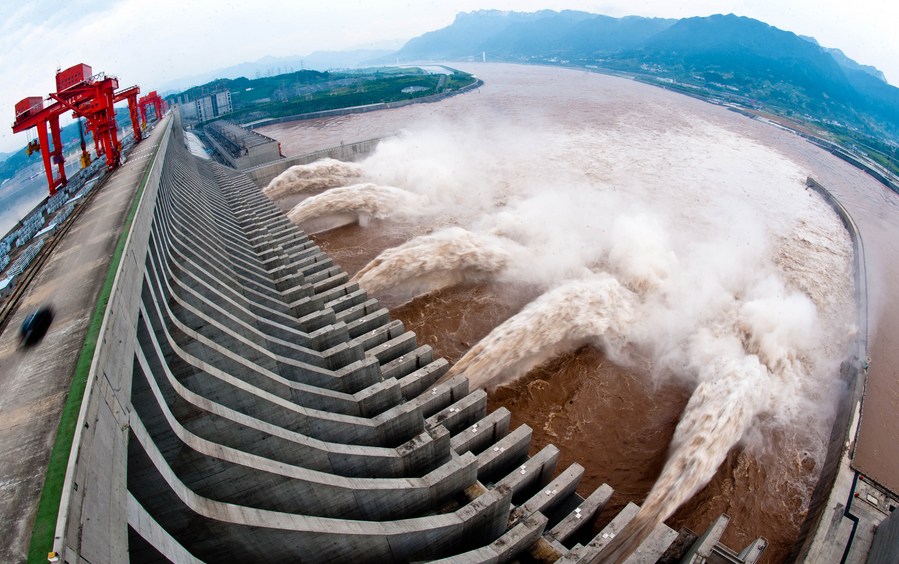KATHMANDU: China has approved the construction of a $137-billion megaproject on the Brahmaputra River, marking it as the world’s largest dam and a groundbreaking feat in global infrastructure development. The dam, located in Tibet near the Indian border, raises significant concerns among downstream riparian states, particularly India and Bangladesh, due to its potential geopolitical and environmental implications.
The Chinese government confirmed the project, to be built on the lower reaches of the Yarlung Zangbo River (the Tibetan name for the Brahmaputra), through an official statement cited by state-run Xinhua news agency on December 25, 2024. This ambitious initiative is set to reshape the hydropower landscape, dwarfing even China’s existing Three Gorges Dam, currently the largest hydropower installation worldwide.
The proposed dam will be situated in a dramatic gorge where the Brahmaputra makes a sharp U-turn before entering India’s Arunachal Pradesh and subsequently flowing into Bangladesh. The project’s scale is unprecedented, with an estimated investment exceeding one trillion yuan ($137 billion). The Hong Kong-based South China Morning Post reported that this colossal endeavor would eclipse any other infrastructure undertaking globally.
Strategic and Environmental Concerns
India and Bangladesh, both heavily dependent on the Brahmaputra for agriculture, drinking water, and livelihoods, have expressed apprehensions about the dam. The project, besides enabling China to regulate water flow, could potentially be weaponized by releasing large volumes of water during geopolitical tensions, triggering floods in downstream regions.
India has voiced particular concerns, as the dam’s construction would empower Beijing to control the river’s flow into Indian territory. Additionally, the dam’s location along a tectonic plate boundary in the seismically active Himalayan region raises significant engineering and safety challenges. Earthquakes are a regular occurrence on the Tibetan plateau, adding to fears about the project’s long-term stability.
To address these apprehensions, China has emphasized the dam’s robust design and ecological safeguards. According to a statement released on December 25, the hydropower project prioritizes ecological protection and incorporates advanced geological and technical measures to ensure safety. The statement also highlighted that extensive geological explorations have laid a solid foundation for the project’s secure and high-quality development.
Harnessing Immense Hydropower Potential
The Brahmaputra, or Yarlung Zangbo River, traverses the Tibetan plateau, carving out the world’s deepest canyon before descending into India. The region is among the most hydropower-rich areas globally, with a vertical drop of 2,000 meters over a 50-kilometer stretch. This topography offers an unprecedented opportunity for hydropower generation.
China’s plans for the dam include drilling multiple 20-kilometer-long tunnels through the Namcha Barwa mountain range to divert approximately half of the river’s flow—about 2,000 cubic meters per second. This ambitious engineering feat will allow the dam to generate over 300 billion kilowatt-hours of electricity annually, sufficient to meet the energy needs of over 300 million people.
Yan Zhiyong, former chairman of the state-owned Power Construction Corporation of China, previously stated that this section of the river offers hydropower resources surpassing the capacity of three Three Gorges Dams combined. The dam’s potential extends beyond power generation, with significant implications for national security, environmental sustainability, and international cooperation.
Balancing Environmental Goals with Development
Chinese authorities have positioned the Brahmaputra dam as a cornerstone of their strategy to achieve carbon neutrality and combat climate change. By harnessing the river’s hydropower potential, the project will create a clean energy base integrating hydro, wind, and solar power. Additionally, the dam is expected to catalyze economic growth in Tibet by generating 20 billion yuan ($3 billion) annually and creating numerous employment opportunities.
The dam is also poised to stimulate related industries, including engineering, logistics, and trade services. It will enhance infrastructure for electricity, water conservancy, and transportation, fostering regional synergy between Tibet and other parts of China. Chinese officials argue that these benefits align with the country’s objectives for high-quality development and a green, low-carbon economy.
However, experts and environmentalists have raised concerns about the ecological impact of such a massive project. While Chinese authorities have assured that the dam will prioritize ecological preservation, questions remain about its potential effects on downstream ecosystems and biodiversity.
Geopolitical Implications for South Asia
India and China, both riparian states of the Brahmaputra, have a long history of disagreements over transboundary river management. To address these issues, the two countries established the Expert Level Mechanism (ELM) in 2006 to facilitate dialogue and data sharing during flood seasons. During recent talks between Indian National Security Advisor Ajit Doval and Chinese Foreign Minister Wang Yi, the importance of data sharing on transboundary rivers was reiterated.
Despite these mechanisms, the Brahmaputra dam adds a new layer of complexity to Sino-Indian relations, already strained due to border disputes. India has also initiated its own dam project on the Brahmaputra in Arunachal Pradesh, signaling a strategic move to counterbalance China’s hydropower ambitions.
Bangladesh, as the third major stakeholder, fears reduced water flow during the dry season, which could severely impact agriculture and drinking water supplies. Both India and Bangladesh are likely to seek diplomatic engagements with Beijing to ensure equitable water sharing and prevent unilateral actions that could destabilize the region.
A Green Future or a Regional Flashpoint?
The Brahmaputra dam represents a double-edged sword. On one hand, it offers China an unparalleled opportunity to advance its renewable energy goals, reduce carbon emissions, and boost regional development in Tibet. On the other hand, it poses significant risks to ecological balance and regional stability, especially in South Asia.
As construction progresses, the project will be closely watched by neighboring countries and the global community. Its success or failure could set a precedent for transboundary river management and large-scale infrastructure development in seismic regions. For India and Bangladesh, the priority will be ensuring that their water rights and ecological concerns are not overshadowed by China’s pursuit of hydropower dominance.

